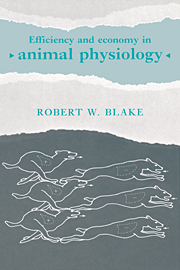Book contents
- Frontmatter
- Contents
- List of contributors
- Preface
- 1 Efficiency, effectiveness, perfection, optimization: their use in understanding vertebrate evolution
- 2 On the efficiency of energy transformations in cells and animals
- 3 Adapting skeletal muscle to be efficient
- 4 Efficiency and other criteria for evaluating the quality of structural biomaterials
- 5 Efficiency and optimization in the design of skeletal support systems
- 6 Efficiency in aquatic locomotion: limitations from single cells to animals
- 7 The concepts of efficiency and economy in land locomotion
- 8 Respiration in air breathing vertebrates: optimization and efficiency in design and function
- 9 Cardiac energetics and the design of vertebrate arterial systems
- 10 An evolutionary perspective on the concept of efficiency: how does function evolve?
- Index
6 - Efficiency in aquatic locomotion: limitations from single cells to animals
Published online by Cambridge University Press: 03 October 2009
- Frontmatter
- Contents
- List of contributors
- Preface
- 1 Efficiency, effectiveness, perfection, optimization: their use in understanding vertebrate evolution
- 2 On the efficiency of energy transformations in cells and animals
- 3 Adapting skeletal muscle to be efficient
- 4 Efficiency and other criteria for evaluating the quality of structural biomaterials
- 5 Efficiency and optimization in the design of skeletal support systems
- 6 Efficiency in aquatic locomotion: limitations from single cells to animals
- 7 The concepts of efficiency and economy in land locomotion
- 8 Respiration in air breathing vertebrates: optimization and efficiency in design and function
- 9 Cardiac energetics and the design of vertebrate arterial systems
- 10 An evolutionary perspective on the concept of efficiency: how does function evolve?
- Index
Summary
INTRODUCTION
Efficiency, commonly defined as the rate of useful energy expenditure divided by the total rate of energy consumption, has been used as a measure of performance for many biological systems, ranging from efficiency of conversion of chemical to mechanical energy, or the conversion of one form of mechanical energy to kinetic or potential energy in moving organisms. In animal locomotion, efficiency has been used as a measure of performance with the idea that maximization of this parameter correlates, in some manner, with increased fitness. Thus animal morphologies, limb kinematics, and even tissue elasticity are commonly examined in light of how these phenotypic features may affect the overall efficiency of moving animals (see for example, Alexander and Bennet-Clark, 1977; Cavagna et al., 1977; Lighthill,1975; Wu, 1971; Weihs and Webb, 1983; Blake, 1983). The extent to which natural selection acts on efficiency in animal locomotion remains unclear. Therefore, rather than examining the maximum attainable efficiencies for moving animals, this Chapter is concerned with the limits to efficiency that may be set by both the physics and physiology of movement in animals. I use aquatic locomotion to illustrate such limitations, examining a broad size range of animals which use diverse modes of propulsion. I seek general trends in the kinematic and morphological factors that affect levels of efficiency. I then delve more deeply into the efficiency limits imposed by the muscles and tissues involved in producing movement.
A simple flow diagram of the steps of energy conversion in a moving animal shows the various levels at which we can examine concepts of efficiency in aquatic locomotion (Fig. 6.1).
- Type
- Chapter
- Information
- Efficiency and Economy in Animal Physiology , pp. 83 - 96Publisher: Cambridge University PressPrint publication year: 1992
- 1
- Cited by



